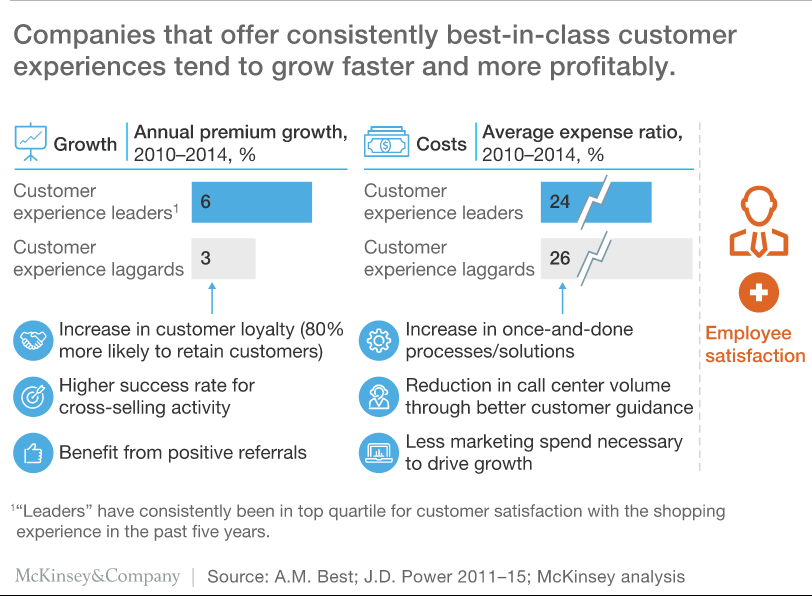Guest blog by Anurag Shah, Aureus Analytics
With the advancement of artificial intelligence (AI) technology, agencies can quickly and cost-effectively leverage the customer data that exists within their systems today to understand their policyholders better and grow their businesses. Just a few years ago, implementing these technologies from a cost perspective was only available to the insurance carriers and a few large agencies/brokers. Today this has all changed. Technology has evolved to the point where independent agencies can have access to the same capabilities. In this article, we will explain how data and analytics tools can help your agency, and outline four ways to grow your agency by leveraging your existing customer data.
This article at a glance:
- Level the playing field with data
- 4 ways to grow your agency with existing customer data
- Identify cross-sell/account rounding opportunities
- Develop loyal customers
- Improve the customer experience
- Be proactive, not reactive
- Use real-time data to improve the tone of the conversation
- Write good business
- Assess prospects quickly
- Know more about existing customers
- Identify bad business
Level the playing field with data
The challenges with leveraging customer data
The challenge for agencies to leverage their customer data to help them better understand their customers is two-fold:
- It continues to be expensive and difficult to access customer data by integrating the data across multiple disparate systems.
- Any interpretation of customer insights is made by humans, which is difficult and time-consuming.
The addition of AI technology is not meant to replace the experience an agent brings when determining the sentiment of an individual or a segment of customers. AI technology is meant to assist (or provide additional insights or information to) agents with their interpretations of how a customer may be feeling or behaving. In the end, it is the agent that makes the decision, not the technology.
AI technology is meant to assist agents with their interpretations of how a customer may be feeling or behaving. In the end, it is the agent that makes the decision, not the technology.
However, AI technology can process mountains of potential customer interaction data from multiple sources faster than any human. That saves time and money for your agency.
This article will illustrate how advancements in AI technologies solve these two challenges, enabling your agency to:
- Be proactive rather than reactive to address customer service issues and identify potential premium uplift opportunities
- Sell the right product at the right time
- Develop stronger and deeper relationships with your customers
Where is customer data stored?
A sound agency management system like HawkSoft records all your prospect, customer, policy, claims, and accounting data, supporting many of the operational needs of your business while enabling the analytics that empower your decision-making. Customer data exists in the form of:
- Contact and demographic information for prospects and customers
- Policies: expirations, underwriting details, risk, and coverage information
- Invoices, receipts, disbursements, and general ledger accounting transactions
- Claims reports, adjuster assignments, and claims payment transactions
- Records of every kind of communication, written (paper, email, and text) or telephonic
- Transactional history notes of all activities for every customer, policy, invoice, and claim
- ACORD Forms including Applications, Binders, Auto ID Cards & Certificates of Insurance
- Electronic documents (i.e., Excel, Word, PDF) and scanned images of all paper materials
- Downloads from insurers of policy details, claims info, premiums, and commissions
Depending on your management system of choice, your electronic documents may be stored on another platform. Some agencies also use more than one management system to run their business, which increases the complexity.
Additionally, there are other systems where customer data is stored that can be challenging to combine with management system data, such as:
- Email systems such as Microsoft Outlook and Gmail
- CRM systems such as Salesforce or Microsoft Dynamics
For an agency with 5,000 customers and 10,000 policies, sorting through all of the data across all the different platforms used for even one customer is cost-prohibitive.
However, modern data analytics systems have the technology to access all of these sources of customer data across multiple management systems, email platforms, communication platforms, and CRM systems without having to merge or integrate the data.
Your data continues to live within the systems that your agency owns and uses today. No data warehouses or tricky integration necessary.
Analyze customer data for insights
Agencies store all this data for reference, in case their actions or those of their insurer partners regarding policies or claims are ever called into question. But all of this data tells another story of how each policyholder feels about the insurance products they have purchased, the service they have received from your agency, and whether they are a customer you should focus on to grow your business.
Data tools like descriptive analytics and AI can glean powerful insights from your customer data instantly and efficiently, eliminating expensive manual labor.
Data tells a story of how each policyholder feels about the insurance products they have purchased, the service they have received from your agency, and whether they are a customer you should focus on to grow your business.
Descriptive analytics is a technology that will be familiar to anyone who uses Amazon for purchases. If I purchase a paintbrush on Amazon, the next time I log in, Amazon will recommend a number of other items such as paint rollers, cans, ladders, etc. that other people similar to me purchased. Amazon does not recommend anything specific, but rather describes a pattern of what other people who buy paintbrushes have purchased.
In the case of an insurance agent, descriptive analytics can make similar recommendations. For example, policyholders between the ages of 20 and 40 who have purchased a lakefront house also tend to purchase some type of watercraft. The watercraft could be many different types of boats or jet skis that may require insurance coverage.
4 ways to grow your agency with existing customer data

Now that accessing and interpreting your customer data is no longer cost-prohibitive, there are 4 practical ways your agency can use your customer data to grow your agency:
- Identify cross-sell/account rounding opportunities
- Develop loyal customers
- Improve the customer experience
- Write good business
1. Identify cross-sell/account rounding opportunities
All agencies strive to cross-sell additional business to existing customers. However, it remains challenging since most account rounding efforts are driven by product and offerings rather than customer needs.
With the help of advanced techniques like external data enrichment, you can obtain more information about every single customer, such as their life stages, hobbies, lifestyle, purchase patterns, etc., and therefore identify the potential cross-sell opportunities that are most relevant to the customer at this specific time.
For example, say your agency has a long-time customer that bought a second home. In addition to the opportunity to sell a second homeowner's policy, what you may not know is that the house is located on a lake. Additional purchase data could tell you that this customer also purchased a boat and two jet skis, which are potential new policy opportunities.
KPIs to measure cross-sell growth
- Premium per customer
- Policies per customer
It's no secret that the addition of additional premium per policies per customer also leads to better retention.
KPIs to measure retention growth
- Customer retention rate
- Premium retention rate
- Customer lifetime (average number of years the customers stay with your agency)
2. Develop loyal customers
 Having the ability to understand the difference between policyholders that simply renew and those who are truly loyal can result in more profitable business.
Having the ability to understand the difference between policyholders that simply renew and those who are truly loyal can result in more profitable business.
Loyal customers stay with your agency for the long haul. They are more interested in value (or having the right policies) as opposed to the lowest possible premium. They value the service your agency provides them and don’t jump ship due to a billing error or bad claims experience.
To develop loyal customers, you need to understand what their overall feeling or sentiment is of your agency, as well as when things are going great or not so great. Even if you are speaking to or surveying these policyholders on a quarterly or even monthly basis, there is no easy way to understand their sentiment at a given point in time.
Understanding the difference between policyholders that simply renew and those who are truly loyal can result in more profitable business. Loyal customers are more interested in value as opposed to the lowest possible premium.
Analytics programs with customer sentiment analysis can assign scores to your customers based on their experience and help you uncover the factors that influence them. Knowing the sentiment of your customers in real-time can help you identify:
- How to deliver the right message at the right time
- More direct customer touchpoints
- Earlier renewal discussions to be proactive in not only retaining but expanding the relationship
KPIs to measure loyal customers
- Customer retention rate
- Customer referrals
- Customer lifetime
3. Improve the customer experience
Since the introduction of the Net Promoter Score back in 2003, there has been an enhanced focus on improving the customer experience in the insurance industry, and with good reason. According to the article, The growth engine: Superior customer experience in insurance (McKinsey & Company), there is a direct link between customer experience and profitable growth.
In addition to faster and more profitable growth, providing an ongoing positive customer experience will affect the loyalty score of your customers.
Be proactive, not reactive
Having the ability to track the sentiment of your customer throughout their customer journey gives you the ability to identify potential customer satisfaction issues and proactively address them. Customer dissatisfaction issues can come from several different areas:
- Bad claim experience
- Payment issues
- Premium increases
- Coverage gaps
A customer satisfaction issue can surface as a result of a negative experience in one or more of these areas. For example, a customer may discover a gap in their coverage within 30 days of policy renewal, and at the same time, their premiums are increasing. This customer is now at risk of non-renewal, and if the agent is unaware of this unhappy customer, they cannot proactively take steps to correct the situation.
At an agency level, understanding the sentiment across all of your customers or specific segments can also help you understand potential challenges within your agency’s service model.
Use real-time data to improve the tone of the conversation
Before picking up the phone to call your customers, your agent will most likely check if the customer they are calling has any upcoming renewals, payment issues, outstanding claims, or other items they should be aware of. But does the agent really know what they are walking into? The customer could be upset, impartial, or happy.
Having access to real-time data empowers the agent to be better prepared to improve the tone of the conversation. The worst thing the agent can do is not be aware of an outstanding claim the customer may be upset about. On the other hand, the best thing the agent can do is have more information at their fingertips that can help them resolve the issue or, at a minimum, reassure the customer that they are fully aware of the customer’s situation.
KPIs to measure customer experience
- Customer sentiment score
- Customer retention rate
- Customer lifetime
4. Write good business
New business will build revenue, but good business will build value. Every agency has its own definition of what qualifies as “good” business for them. Regardless of what that definition is, the more information you have about your customers, the better decisions you can make about whether a customer is worth taking on.
New business will build revenue, but good business will build value. The more information you have about your customers, the better decisions you can make about whether a customer is worth taking on.
Assess prospects quickly
One of the challenges faced by agents in writing good business is time. Do agencies have enough information to determine if they are bringing on good business within the amount of time they have to provide a quote? Having more data earlier in the process can help an agent make a more accurate determinate about a customer.
Know more about current customers
Similar to prospects, having more information on your existing customers who may be looking for additional covers will help you to decide how valuable that business is for your agency. You can use a combination of external and internal data to drive this decision making.
Identify bad business
We’re all familiar with the phrase, “not all business is good business.” As an agency owner, you want to avoid bad business to begin with, and jettison bad business that is affecting the profitability of your agency. Customer data can help you identify and deal with unprofitable customers.
KPIs for writing good business
- Lower loss ratio
- Higher retention rates
- Minimal or no fraudulent claims
Customer data: the diamonds in your backyard
The advancement of artificial intelligence and data analysis technologies has leveled the playing field for independent agencies. Today, agencies can quickly and cost-effectively leverage the customer data that already exists within their systems to understand their policyholders better and grow their businesses.
Agents now have the technology to help them access and interpret the valuable customer data residing in their agency management and other systems. There are a variety of options for putting data to use by employing systems like DONNA by Aureus Analytics that use descriptive analytics, machine learning, and artificial intelligence. With the help of data tools, your agency can identify cross-selling opportunities, develop loyal customers, improve the customer experience, and write better business.
Leverage your HawkSoft Data with DONNAAdd DONNA integration to HawkSoft through HawkSoft Marketplace to get analytics at a glance, customer sentiment scoring, real-time customer behavior prediction, external data enrichment, and more. |








